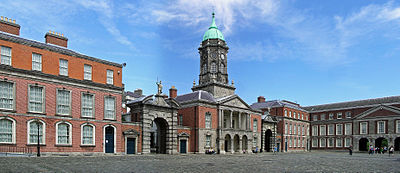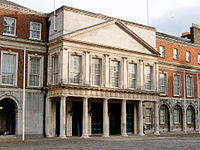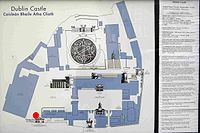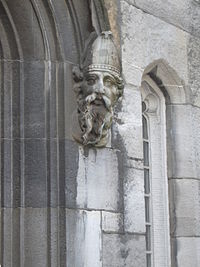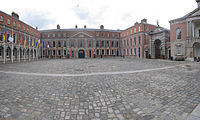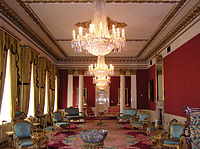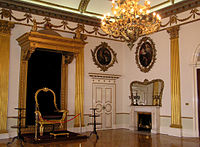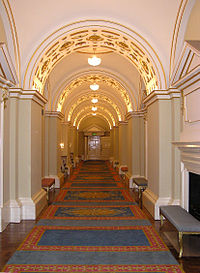- Dublin Castle
-
Dublin Castle, Upper Yard

The Bedford Tower of 1761 comprises the centrepiece of the Castle's principal Georgian courtyard, flanked by the gates of Fortitude and Justice. It was from this building the Irish Crown Jewels were stolen in 1907.Dublin Castle (Irish: Caisleán Bhaile Átha Cliath) off Dame Street, Dublin, Ireland, was until 1922 the fortified seat of British rule in Ireland, and is now a major Irish government complex. Most of it dates from the 18th century, though a castle has stood on the site since the days of King John, the first Lord of Ireland. The Castle served as the seat of English, then later British government of Ireland under the Lordship of Ireland (1171–1541), the Kingdom of Ireland (1541–1800), and the United Kingdom of Great Britain and Ireland (1800–1922). Upon establishment of the Irish Free State in 1922, the complex was ceremonially handed over to the newly formed Provisional Government led by Michael Collins.[1]
Contents
Roles
Dublin Castle fulfilled a number of roles through its history. Originally built as a defensive fortification for the Norman city of Dublin, it later evolved into a royal residence, resided in by the Lord Lieutenant of Ireland or Viceroy of Ireland, the representative of the monarch. The second in command in the Dublin Castle administration, the Chief Secretary for Ireland, also had his offices there. Over the years parliament and law courts met at the castle before moving to new purpose-built venues. It also served as a military garrison. Upon formation of the Free State in 1922, the castle assumed for a decade the role of the Four Courts on the Liffey quays which had been badly damaged during the Civil War.
It was decided in 1938 that the inauguration of the first President of Ireland, Douglas Hyde would take place in the castle, and the complex has been host to this ceremony ever since. The castle is also used for hosting official State visits as well as more informal foreign affairs engagements, State banquets, and Government policy launches, as well as acting as the central base for Ireland's hosting of the European Presidency approximately every 10 years.
History
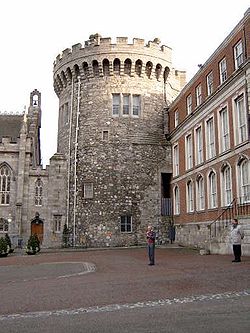 The Record Tower, the sole surviving tower of the mediæval castle dating from c.1228.
The Record Tower, the sole surviving tower of the mediæval castle dating from c.1228.
To its left is the Chapel Royal.Dublin Castle was first founded as a major defensive work by Meiler Fitzhenry on the orders of King John of England in 1204,[2] some time after the Norman invasion of Ireland in 1169, when it was commanded that a castle be built with strong walls and good ditches for the defence of the city, the administration of justice, and the protection of the King’s treasure.[3] Largely complete by 1230, the castle was of typical Norman courtyard design, with a central square without a keep, bounded on all sides by tall defensive walls and protected at each corner by a circular tower. Sited to the south-east of Norman Dublin, the castle formed one corner of the outer perimeter of the city, using the River Poddle as a natural means of defence along two of its sides. The city wall directly abutted the castle’s north-east Powder Tower, extending north and westwards around the city before rejoining the castle at its south-western Bermingham Tower. The Poddle was diverted into the city through archways where the walls adjoined the castle, artificially flooding the moat of the fortress's city elevations. One of these archways and part of the wall survive buried underneath the 18th century buildings, and are open to public inspection.
Through the Middle Ages the wooden buildings within the castle square evolved and changed, the most significant addition being the Great Hall built of stone and timber, variously used as Parliament house, court of law and banqueting hall. The building survived until 1673, when it was damaged by fire and demolished shortly afterwards. No trace of medieval buildings remains above ground level today, with the exception of the great Record Tower (ca. 1228-1230); it the sole surviving tower of the original fortification, its battlements an early 19th-century addition.[4]
"Castle Catholic" was a pejorative term for Catholics who were considered to be overly friendly with or supportive of the British administration.
United Irishmen General Joseph Holt, a participant in the 1798 Rising, was incarcerated in the Bermingham Tower before being transported to New South Wales in 1799.
Famously, the Irish Crown Jewels were stolen from the Castle in 1907.
During the Anglo-Irish War the Castle was the nerve centre of the British effort against Irish separatism. On the night of Bloody Sunday in 1920, three Irish Republican Army members Dick McKee, Conor Clune and Peadar Clancy, were tortured and killed.[5][6][7]
When the Irish Free State came into being in 1922, Dublin Castle ceased to function as the administrative seat. It served for some years as temporary Courts of Justice (the Four Courts, the home of the Irish courts system, had been destroyed in 1922). After the courts vacated the premises, the Castle was used for state ceremonial. As President of the Executive Council, Éamon de Valera received credentials there from newly arrived ambassadors to Ireland on behalf of King George V in the 1930s. In 1938, Douglas Hyde was inaugurated as President of Ireland at the Castle. Inaugurations of subsequent presidents took place there in 1945, 1952, 1959, 1966, 1973, 1974, 1976, 1983, 1990, 1997 and 2011. President Erskine Hamilton Childers' lying-in-state took place there in November 1974, as did that of former President Éamon de Valera in September 1975.
The castle is a tourist attraction and, following major refurbishment, is also used as a conference centre. During Ireland's presidencies of the European Union, including most recently in the first half of 2004, it has been the venue of many meetings of the European Council. The crypt of the Chapel Royal is now used as an arts centre, and occasional concerts are held in the grounds of the Castle. The complex of buildings is usually open to the public, except during state functions.
State Apartments
 St Patrick's Hall
St Patrick's Hall
The State Apartments,[8] located in the southern range of buildings of the Upper Yard, contain the rooms formerly used by the Lord Lieutenant for personal accommodation and public entertaining during the Castle Season. Today these richly decorated rooms are used by the Irish Government for official engagements including policy launches, hosting of State Visit ceremonial, and the inauguration of the President every seven years. The principal rooms of the State Apartments include:
- Saint Patrick's Hall
This is the grandest room of the State Apartments, and contains one of the most important decorative interiors in Ireland. Formerly the ballroom of the Lord Lieutenant's administration, today the room is used for presidential inaugurations. It is one of the oldest rooms in the castle, dating from the 1740s, though its decoration largely dates from c. 1790, including the most significant painted ceiling in Ireland executed by Vincenzo Valdre (c. 1742–1814). Composed of three panels, the ceiling depicts the coronation of King George III, Saint Patrick introducing Christianity to Ireland, and King Henry II receiving the submission of the Irish Chieftains. The state dinner, hosted by the President of Ireland to welcome Queen Elizabeth II to Ireland, was held here on the evening of May 18, 2011
- Throne Room
Originally built as the Battleaxe Hall in the 1740s, it was converted to a Presence Chamber around 1790. The regal decoration dates from that time and from alterations in the 1830s. It contains a throne built for the visit of King George IV to Ireland in 1821.
- State Drawing Room
Built in the 1830s as the principal reception room of the Lord Lieutenant and his household, today this room is reserved in use for the reception of foreign dignitaries. Largely destroyed by fire in 1941, the room was reconstructed with minor modifications in 1964–1968 by the OPW, making use of salvaged and replicated furnishings and fittings.
- State Dining Room
Also called the Picture Gallery, and formerly known as the Supper Room, this is the oldest room in the castle and largely retains its original decoration, having escaped major modification and fire over the years. It dates from Lord Chesterfield's building of the State Apartments in the 1740s, and was intended for use as a supper room adjoining St. Patrick's Hall and as a personal dining room. Today the room is still used for dining when conferences take place in St. Patrick's Hall.
- State Bedrooms
These former private quarters of the Lord Lieutenant were built as five interconnecting rooms running along the back of the building, adjoining the spine corridor that separates them from the State Drawing Room. Completely rebuilt in the 1960s following fire in 1941, the rooms maintain the original courtly sequence and today are used as ancillary drawing and meeting rooms to the principal apartments. The last dignitary to stay in the royal bedrooms was Margaret Thatcher, who spent a night there with her husband Dennis during one of the European Council meetings held in the 1980s.
- State Corridor
The most architectural space of the State Apartments, this expressive, deeply modelled corridor was originally built c. 1758 to the designs of the Surveyor General, Thomas Eyre. Based on the early 18th century corridor of Edward Lovett Pearce in the former Parliament House on College Green, it features a marching procession of vaults and arches which were originally top-lit. Regrettably an office storey was built over the skylights following complete reconstruction of the corridor in the 1960s as the result of differential settlement with the reconstruction of the adjoining Drawing Room. The corridor features exact plaster casts of the original arch detailing, and the original doorcases and fireplaces salvaged prior to rebuilding.
Dublin Castle is currently maintained by the Office of Public Works, and houses, among other things, offices of the Revenue Commissioners in a 20th century building at the end of the Castle Yard, some elements of the Office of Public Works itself in an old stables area, and some functions of the Garda Síochána.
The castle complex also hosts the Chester Beatty Library, in a purpose-constructed facility.
Film
Dublin Castle has appeared in numerous films including Barry Lyndon, Michael Collins, Becoming Jane and The Medallion, as well as the television series The Tudors, where it doubles as the Vatican in the pilot.
Music
Dublin Castle hosts the Heineken Green Energy festival each May bank holiday weekend. Part of Dublin Castle appears on the cover of the Jandek album Khartoum Variations.
See also
- Castles in Great Britain and Ireland
- Chapel Royal
- Dublin Castle administration in Ireland
- List of castles in Ireland
References
- ^ Costello, Peter (1999). Dublin Castle, in the life of the Irish nation. Dublin: Wolfhound Press. ISBN 0-86327-610-5.
- ^
 "Fitzhenry, Meiler". Dictionary of National Biography. London: Smith, Elder & Co. 1885–1900.
"Fitzhenry, Meiler". Dictionary of National Biography. London: Smith, Elder & Co. 1885–1900. - ^ McCarthy, Denis; Benton, David (2004). Dublin Castle: at the heart of Irish History. Dublin: Irish Government Stationary Office. pp. 12–18. ISBN 0-75571-9751.
- ^ Dublin Castle (last modified 2002). "Dublin Castle web-site (history)". Dublin Castle. Archived from the original on 2008-08-01. http://web.archive.org/web/20080801180715/http://www.dublincastle.ie/history.html. Retrieved 2008-08-20.
- ^ Sean O'Mahony, Death in the Castle: Three murders in Dublin Castle 1920. 1916/1921 Club
- ^ Dwyer, T. Ryle, The Squad (2005)
- ^ MacLysaght, Changing Times (1978)
- ^ McCarthy, Denis; Benton, David (2004). Dublin Castle: at the heart of Irish History. Dublin: Irish Government Stationary Office. pp. 128–130. ISBN 0-75571-9751.
External links
- Dublin Castle website
- Official Tourist Board Website for Dublin
- Ireland.archiseek.com, entry on Dublin Castle (including pictures)
Coordinates: 53°20′35″N 6°16′03″W / 53.343109°N 6.267394°W
Irish State and Public buildings (pre- & post-independence) Áras an Uachtaráin · Central Bank of Ireland · Chapel Royal · Chichester House · Chief Secretary's Lodge · Collins Barracks · Custom House · Dublin Castle · Farmleigh · Four Courts · General Post Office (GPO) · Government Buildings · Green Street Court House · Old Parliament House · Leinster House · Little Ratra · Steward's Lodge · Under Secretary's Lodge
Official and personal residences used by the Irish viceroy (1500s–1922) Abbeyville · Chapelizod House · Dublin Castle · Durhamstown Castle · St. Wolfstan's · Viceregal Lodge
Categories:- Castles in Dublin (city)
- Royal residences in the Republic of Ireland
- Norman architecture
- Government buildings in Ireland
- Museums in Dublin (city)
- Historic house museums in the Republic of Ireland
- Archaeological sites in County Dublin
Wikimedia Foundation. 2010.

